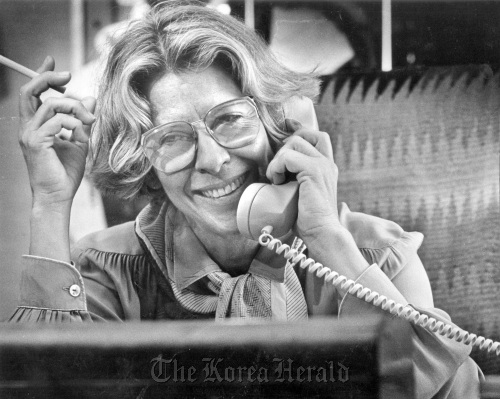Geez, there was never anyone, and I really mean anyone, who was more fun to talk to about movies than Polly Platt, who died last week at age 72 after a battle with Lou Gehrig’s disease.
She was the ultimate behind-the-scenes figure in Hollywood, the woman who was something of a svengali, mentor and sounding board for a variety of big-shot directors, from Peter Bogdanovich and Jim Brooks to Cameron Crowe and Wes Anderson. She also was a groundbreaking figure, as a female production designer, on “The Last Picture Show,” and producer, on “Broadcast News.” She also worked as a screenwriter on a variety of films, including “Pretty Baby” and “A Map of the World.”
 |
Polly Platt on the phone at her office at Paramount Pictures in Hollywood in 1984. (Bob Chamberlin/Los Angeles Times/MCT) |
One of the many people in Hollywood who saw her as a mentor was Stacey Sher, producer of “Erin Brockovich,” “Out of Sight” and the upcoming Steven Soderbergh film “Contagion.” “Polly was my inspiration and the ultimate creative muse,” she told me Wednesday. “She was a rock star. She knew how to do everybody’s job as well as they did. If she’d been born 20 years later, she probably would’ve been the first woman to win an Oscar for best director.”
I got to know Platt over the years and always felt as if I was hanging around a living and breathing movie encyclopedia. In the early days of her marriage to Bogdanovich, when he was still a nerdy movie journalist, she would accompany him to film sets, where the couple spent endless hours with film gods such as Howard Hawks and John Ford, seeing them up close and personal. Platt soaked up everything they said, passing along the lessons to her own young charges.
She would always tell first-time directors what Ford had told her and Bogdanovich, when asked why he never covered a scene from a number of different angles. Ford said he didn’t want his actors to just be mouthing words take after take. “If you get the first or second take,” he said, “there’s a sparkle, an uncertainty about it. They’re not sure of their lines, and it gives you a sense of nervousness and suspense that you’d never get after 15 or 20 takes.”
Platt was also refreshingly politically incorrect. When I was doing a column a couple of years ago about the depressing paucity of women directors working on studio films, she riled up a lot of women in Hollywood by bluntly saying that men, in terms of psychological temperament, were better suited for the job. Women walked softly, but men liked to swing a big stick.
“Men just enjoy being in charge more,” she told me. She recalled Bogdanovich arriving on the set of “Paper Moon” in a limousine, eager to make a big entrance. “Peter adored that stuff,” she said. “But most of the women I know didn’t enjoy the perks of the job, like when you walk onto the set and everyone’s waiting for you to make a decision. Having 150 people all waiting to hear your answers to every question ― most women would find that terrifying.”
There was no greater pleasure than watching a movie with Platt, who had an incredible eye for nuance and texture. When Sher watched “Shampoo” with Platt one night, she was astounded at the details Platt saw in the film. “We got to the scene where you see Julie Christie for the first time, wearing these big sunglasses. She was about to deliver her first line when Polly shouted out, ‘Laszlo Kovacs (the film’s cinematographer), get your lights out of those glasses!’
“And sure enough, you could see the reflection of Kovacs’ lights in Christie’s sunglasses. It was amazing, because it’s one of my favorite films that I’d watched a million times, but I’d never noticed it before. Of course, every time I’ve watched the film since, whenever I get to that scene, I always think of Polly.”
Platt couldn’t have asked for a better legacy. I’m going to watch one of her old films this weekend ― maybe “The Last Picture Show” or “Broadcast News” or “Say Anything,” which she also helped produce ― and think of her keen eye, wondering what she might have seen in a casual actor’s glance or heard in a throwaway snatch of dialogue that no one else would ever have managed to notice.
By Patrick Goldstein, Los Angeles Times
(McClatchy-Tribune Information Services)








